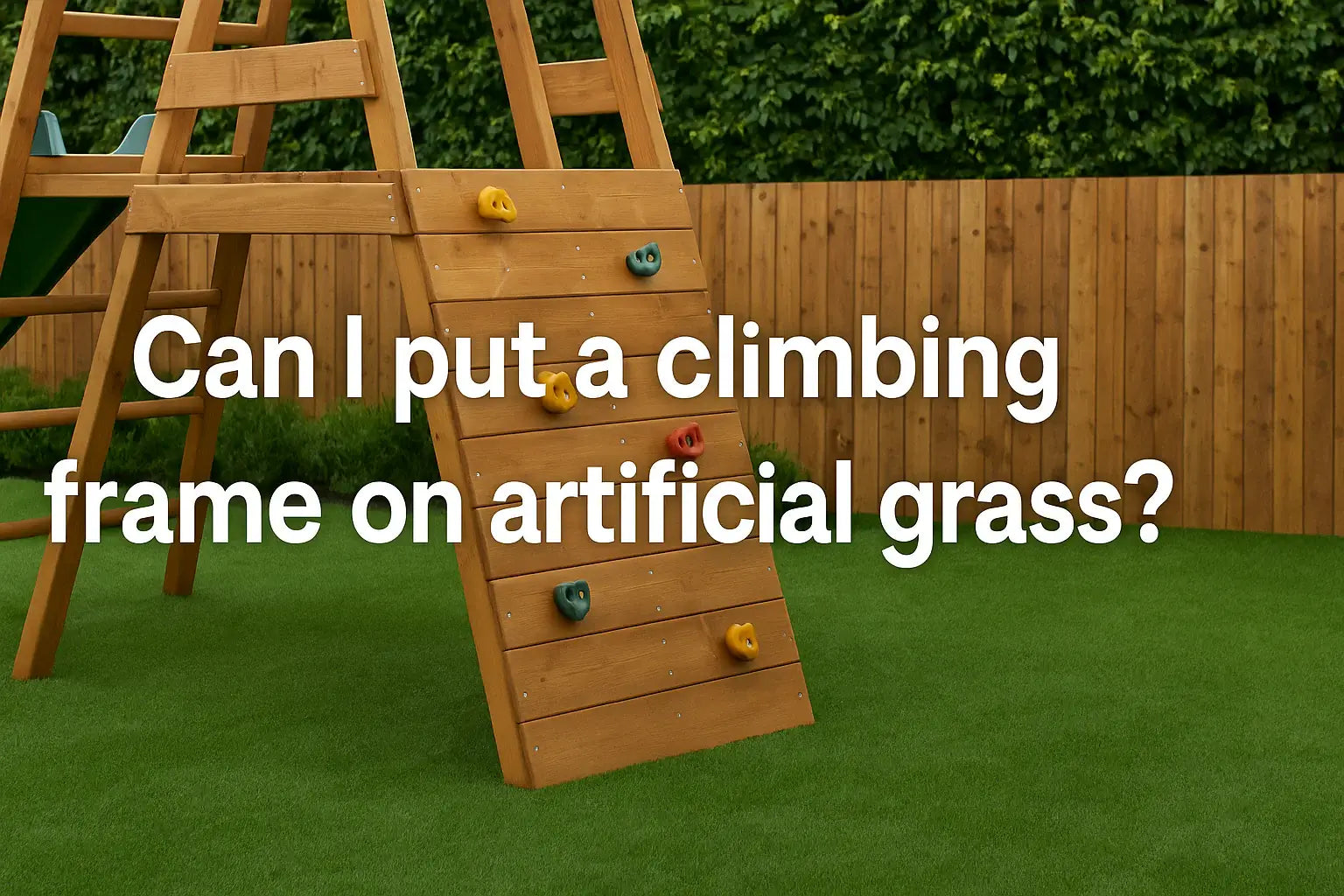
Can I Put A Climbing Frame On Artificial Grass?
Thinking of plonking a garden climbing frame on your pristine fake lawn? Short answer: yes, you can! But there’s a bit more to it. From squished turf to safety tricks, we’ve got the tips every parent needs before turning their garden into a mini adventure zone.
Benefits and Considerations of Artificial Grass for Climbing Frames
Advantages of Artificial Grass for Play Areas
Enhanced Durability and Longevity
Let’s face it—kids don’t go easy on your garden. Whether they’re launching themselves off monkey bars or turning the climbing frame into a pirate ship, your lawn takes a beating. Luckily, high-quality artificial grass can handle the rough and tumble better than most natural turf. It holds its shape, doesn’t bald easily, and can bounce back with a bit of brushing. That means less mud, less mess, and more play.
All-Weather Usability and Reduced Mud
Rainy day? No problem. Synthetic grass drains fast and stays usable in all seasons, so you’re not stuck dealing with puddles or muddy footprints through the kitchen. Unlike natural grass, it doesn’t turn to sludge under heavy use. That means more time climbing and less time cleaning.
Improved Cleanliness and Hygiene
Fake grass doesn’t grow weeds or attract the same level of bugs. And if your child drops their sandwich mid-play, it’s a much cleaner surface to land on. Parents often mention how easy it is to keep clean with a quick brush or rinse. It’s peace of mind, especially when the toddler’s crawling around with who-knows-what on their hands.
Allergy-Friendly Surface
If you’ve got a hay fever sufferer at home, artificial grass can be a game-changer. No pollen, no itchy eyes, and no grassy noses. Just clean, green, sneeze-free fun.

Safety Features of Artificial Grass Play Surfaces
Cushioning and Shock Absorption (Critical Fall Height)
Safety first—always. When paired with the right underlay, artificial turf can meet critical fall height standards. That means it can help cushion falls from swings or climbing frames. Add a shock pad underneath and you’ve got a surface that’s both soft and strong.
Reduced Risk of Slips and Falls
Kids run. Kids fall. But artificial grass gives them a fighting chance of staying upright. Its even surface and built-in drainage help prevent slippery spots that could cause a tumble.
Non-Toxic and Safe Materials
Modern synthetic turf is designed with families in mind. Most types are free from lead and other harmful chemicals. It’s safe for bare feet, curious toddlers, and yes—even dogs that think the frame is their new lookout post.
Potential Downsides and Important Considerations
Heat Absorption in Direct Sunlight
Artificial grass can get hot in strong sun, especially during heatwaves. If your climbing frame’s in full sun, think about adding a shade sail or setting up play during cooler times of day. Shoes are a must on those scorchers.
Environmental Impact and Drainage Considerations
It’s true—artificial grass is made from plastic. So while it saves water and avoids fertilisers, it’s worth considering its long-term impact. Proper drainage is also crucial, especially under heavy equipment. Pooled water underneath can lead to smells or surface damage over time.
Initial Cost vs. Long-Term Maintenance Savings
Fitting artificial grass isn’t cheap. But it pays off quickly—no mowing, no reseeding, no fertilising. Many parents find the trade-off worth it after their first hassle-free summer.

Installation and Anchoring Techniques for Climbing Frames on Artificial Grass
Essential Site Preparation
Ensuring a Flat and Stable Base Layer
Before you even think about setting up that climbing frame, check your turf. It needs to be level and firmly secured to its base layer. Any uneven spots can lead to wobbly frames or safety issues.
Clearing Debris and Optimising Drainage
Remove any leftover construction bits, stones, or rogue branches. And while you’re at it, double-check your drainage. Standing water and artificial grass do not mix well.
Choosing the Right Anchoring Method
Ground Anchors vs. Concrete Foundations
Your climbing frame needs to stay put—even after the wildest play session. Ground anchors work great for most artificial lawns, as they don’t disrupt the surface much. Heavier structures might call for concrete bases, especially if the frame is permanent.
Considerations for Different Climbing Frame Types
Wooden frames? They often need more stabilising. Lightweight plastic sets? You might want to move them around to prevent wear in one spot. Either way, matching the anchor method to your frame is key.
Step-by-Step Anchoring Process
Making Precise Cuts in the Artificial Grass
To install anchors, cut small sections of the turf where needed. Use a sharp blade and go slow—clean cuts mean cleaner finishes. You’ll want to expose just enough of the sub-layer to get the job done without damaging the rest of your lawn.
Installing Ground Anchors Securely
Hammer the anchors deep into the ground so they don’t budge. For extra protection, use rubber pads or mats under the frame legs to spread the load and reduce pressure.
Attaching the Climbing Frame to Anchors
Once the anchors are in, connect them securely to your climbing frame. Follow manufacturer guidelines closely—wobbly isn’t fun, and it definitely isn’t safe.
The Role of Shock Pad Underlay
Meeting Critical Fall Height Standards
Installing a shock pad under your turf can add crucial cushioning. It helps absorb the impact of falls and meets the standards set for playground safety.
Types of Underlay and Their Benefits
Foam pads are popular for home use, but rubber mats and composite layers offer heavy-duty protection. Choose the one that suits your family’s play style and the height of your frame.
Professional Installation vs. DIY Approaches
When to Hire a Professional
If your climbing frame is big, heavy, or high—you might want a pro. They’ll handle everything from drainage to anchoring so you don’t have to worry.
Tips for a Successful DIY Installation
Still want to go the DIY route? Take your time, read the instructions twice, and make sure everything is level and secure. And don’t forget a celebratory cuppa when you're done.

Maintaining Your Artificial Grass Play Area with a Climbing Frame
Routine Cleaning and Care
Hosing Down and Removing Debris
A quick rinse with the hose and a soft-bristle brush does wonders. Get rid of leaves, crumbs, or rogue toys that might be hiding in the blades.
Addressing Spills and Pet Waste
Accidents happen. Clean spills quickly with water and a gentle cleaner. For pet mess, scoop it up and rinse the area well.
Addressing Wear and Tear
Brushing and Redistributing Infill
Over time, your artificial grass may start to look a bit tired—especially around the climbing frame. Brushing helps lift the blades and keeps things looking fresh. If you’ve got infill, redistribute it evenly.
Preventing Matting and Damage Around High-Traffic Areas
Consider rotating your climbing frame every few months if it’s light enough. Protective mats also help reduce pressure where feet land most often.
Long-Term Maintenance and Lifespan
Extending the Life of Your Artificial Grass
Regular care means your turf stays lush for longer. Keep an eye out for loose seams, flat patches, or drainage issues.
Recognising When Replacement Might Be Needed
If your grass starts looking sad—faded, frayed, or flattened beyond repair—it might be time to replace it. Especially if safety is at stake.
By planning well and staying on top of maintenance, a garden climbing frame on artificial grass can be a win-win. It gives your kids a safe, year-round play zone—and gives you fewer muddy footprints to clean up.
Have you checked out our other posts?
Can I Put A Climbing Frame In My Garden?
How High Can A Climbing Frame Be?
Do Climbing Frames Need Planning Permission?
Can You Put A Climbing Frame On A Slope?
Can You Put A Climbing Frame On Concrete?
What Is Best To Put Under A Climbing Frame?



Leave a comment